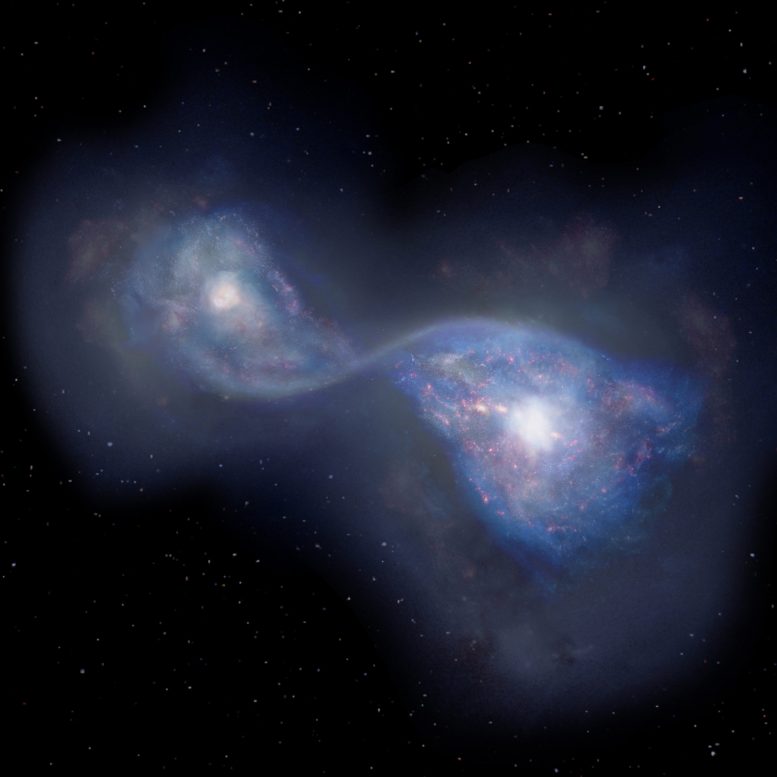
Artist’s impression of the merging galaxies B14-65666 located 13 billion light years-away. Credit: National Astronomical Observatory of Japan
Researchers using the radio telescope ALMA (Atacama Large Millimeter/submillimeter Array) observed signals of oxygen, carbon, and dust from a galaxy in the early Universe 13 billion years ago. This is the earliest galaxy where this useful combination of three signals has been detected. By comparing the different signals, the team determined that the galaxy is actually two galaxies merging together, making it the earliest example of merging galaxies yet discovered.
Takuya Hashimoto, a postdoctoral researcher at the Japan Society for the Promotion of Science and Waseda University, Japan, and his team used ALMA to observe B14-65666, an object located 13 billion light-years away in the constellation Sextans. Because of the finite speed of light, the signals we receive from B14-65666 today had to travel for 13 billion years to reach us. In other words, they show us the image of what the galaxy looked like 13 billion years ago, less than 1 billion years after the Big Bang.
ALMA detected radio emissions from oxygen, carbon, and dust in B14-65666. This is the earliest galaxy where all three of these signals have been detected. The detection of multiple signals is important because they carry complementary information.
Data analysis showed that the emissions are divided into two blobs. Previous observations with the Hubble Space Telescope (HST) revealed two-star clusters in B14-65666. Now with the three emission signals detected by ALMA, the team was able to show that the two blobs do in fact form a single system, but they have different speeds. This indicates that the blobs are two galaxies in the process of merging. This is the earliest known example of merging galaxies. The research team estimated that the total stellar mass of B14-65666 is less than 10% of that of the Milky Way. This means that B14-65666 is in the earliest phases of its evolution. Despite its youth, B14-65666 is producing stars 100 times more actively than the Milky Way. Such active star formation is another important signature of galactic mergers because the gas compression in colliding galaxies naturally leads to bursty star formation.
“With rich data from ALMA and HST, combined with advanced data analysis, we could put the pieces together to show that B14-65666 is a pair of merging galaxies in the earliest era of the Universe,” explains Hashimoto. “Detection of radio waves from three components in such a distant object clearly demonstrates ALMA’s high capability to investigate the distant Universe.”
Modern galaxies like our Milky Way have experienced countless, often violent, mergers. Sometimes a larger galaxy swallowed a smaller one. In rare cases, galaxies with similar sizes merged to form a new, larger galaxy. Mergers are essential for galaxy evolution, so many astronomers are eager to trace back the history of mergers.
“Our next step is to search for nitrogen, another major chemical element, and even the carbon monoxide molecule,” said Akio Inoue, a professor at Waseda University. “Ultimately, we hope to observationally understand the circulation and accumulation of elements and material in the context of galaxy formation and evolution.”
Reference: “Big Three Dragons”: a z = 7.15 Lyman Break Galaxy Detected in [OIII] 88 um, [CII] 158 um, and Dust Continuum with ALMA” by Takuya Hashimoto, Akio K. Inoue, Ken Mawatari, Yoichi Tamura, Hiroshi Matsuo, Hisanori Furusawa, Yuichi Harikane, Takatoshi Shibuya, Kirsten K. Knudsen, Kotaro Kohno, Yoshiaki Ono, Erik Zackrisson, Takashi Okamoto, Nobunari Kashikawa, Pascal A. Oesch, Masami Ouchi, Kazuaki Ota, Ikkoh Shimizu, Yoshiaki Taniguchi, Hideki Umehata and Darach Watson, 17 June, 2019, Publications of the Astronomical Society of Japan.
DOI: 10.1093/pasj/psz049

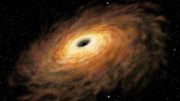
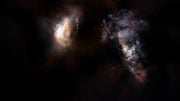

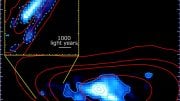
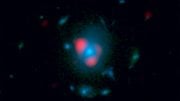
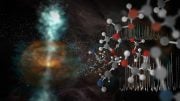
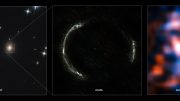
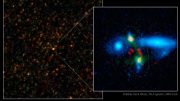
Parece que todo el conocimiento del universo puede ser revaluado.
Si a solo 250 millones de años del Big Bang ya había estrellas, y a 750 millones de años ya se fusionaban galaxias, entonces cuando se crearon los ambientes para la creación de la vida?
Según esto, en el universo puede existir la vida desde muchos cientos de millones de años antes de lo que se pensaba.
Tu pregunta es válida, Israel. Esta pregunta es la mentira de la teoría del Big Bang; No hay ninguna posibilidad de que las estrellas que forman estas dos galaxias tengan menos de 10 mil millones de años de edad cuando se fusionen para formar sus galaxias individuales, y debe haber habido una cantidad significativa de tiempo antes de que finalmente comenzaran a fusionarse. !
Así que no hubo un ‘Big Bang’ hace 13.7 mil millones de años, ya que existían estrellas y galaxias completamente formadas.
Nuestro propio sol tiene más de 4 mil millones de años y, ciertamente, no es la estrella más antigua de nuestra galaxia. ¿Por qué esperaríamos que las estrellas de cualquier otra galaxia sean más jóvenes?
Your question is valid, Israel. This question lends the lie to the Big Bang theory; There is no chance that the stars that make up these two galaxies could be any less than 10 billion years of age by the time they merged to form their individual galaxies, and there must have been a significant amount of time before they finally began to merge!
So there was no ‘Big Bang’ 13.7 billion years ago, as there were fully-formed stars and galaxies in existence.
Our own sun is over 4 billion years old and is certainly not the oldest star in our galaxy, so why would we expect the stars in any other galaxy to be any younger?!
This is the most beautiful picture I have ever seen and I am 72 years old.